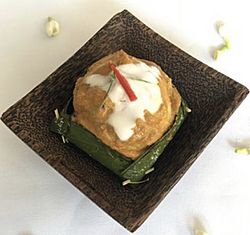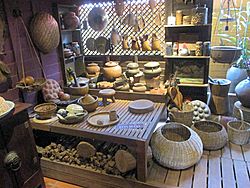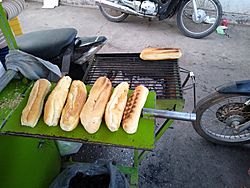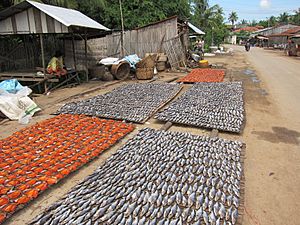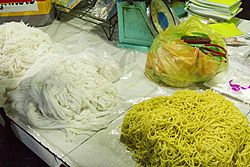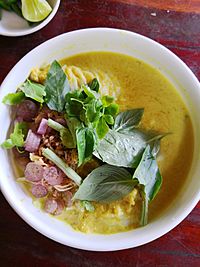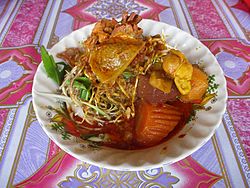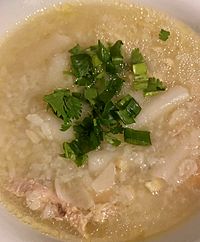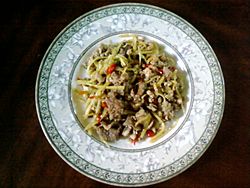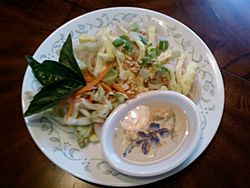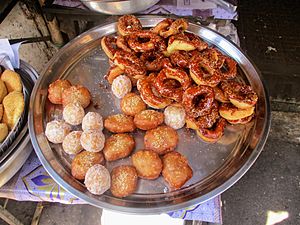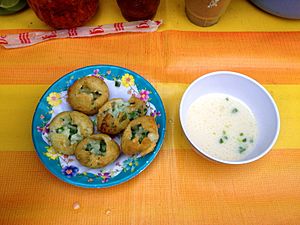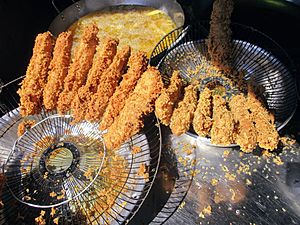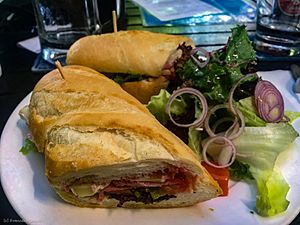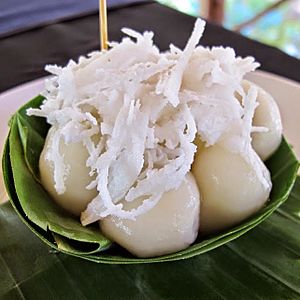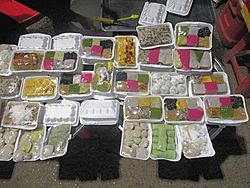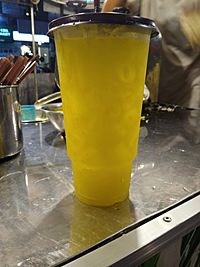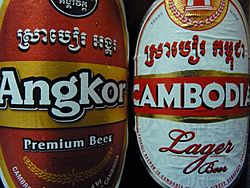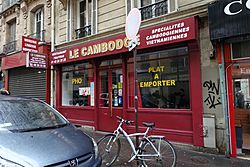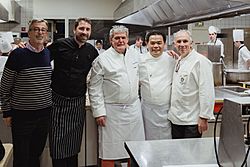Cambodian cuisine facts for kids
Cambodian cuisine is an umbrella term for the cuisines of all ethnic groups in Cambodia, whereas Khmer cuisine (Khmer: សិល្បៈធ្វើម្ហូបខ្មែរ; lit. Khmer culinary art) refers specifically to the cuisine of the Khmer people. Over time, Cambodian cuisine has incorporated elements of Indian, Chinese and more recently French cuisine, and due to some of these shared influences and mutual interaction, it has many similarities with the neighbouring Thai, Vietnamese and Lao cuisines.
Khmer cuisine can be classified into peasant, elite and royal cuisine, although the difference between the royal and popular cuisine is not as pronounced as in the case of Thailand and Laos. The royal and elite dishes use more varied and higher quality ingredients, and contain more meat, while the peasant food is made from simpler and more accessible ingredients.
Contents
History
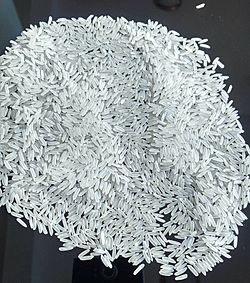
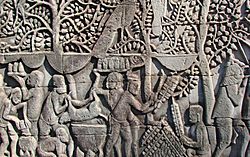
Because of Cambodia's geographic location, rice and fish, especially freshwater fish, are the two most important sources of nutrients in the Cambodian diet. Rice is a staple food generally eaten at every meal. It is believed to have been cultivated in the territory of Cambodia since 5,000 to 2,000 B.C. The advanced hydraulic engineering developed during the Khmer Empire allowed the Khmer to harvest rice and other crops three to four times a year. According to the International Rice Research Institute, there are approximately 2,000 rice varieties indigenous to Cambodia bred over the centuries by the Cambodian rice farmers. One of them – "Malys Angkor" (ម្លិះអង្គរ, Mlih Ángkô) – has been regarded the world's best rice.
Many spices in Khmer cuisine were introduced by the Indian merchants around the 2nd century. The Indian influence on cuisine among other aspects of Khmer culture was already noted by a Chinese visitor around 400 AD. The trace of Indianization can be seen in the coconut-based curries (ការី, kari), as well as boiled red and white sweets. The Chinese began arriving in Khmer Empire in the 13th century, bringing their cuisine with them, from which Cambodian cuisine adopted an extensive use of noodles and stir frying.
From the 9th to the 15th century the culinary influence of the growing Khmer Empire spread beyond the borders of modern-day Cambodia into what is now Thailand, Laos, Vietnam, and Indonesia. The Khmer palace food developed into a refined royal cuisine and through the Khmer royal cooks brought to the Ayutthaya Kingdom strongly influenced the Thai royal cuisine. The original Khmer palace recipes were modified in the Ayutthaya Kingdom, where during the reign of King Narai they also acquired a Portuguese influence and were eventually reintroduced back into Cambodia as the Siamese armies attacked into Cambodia. New Zealand Cambodian chef Kethana Dunnet has even dubbed Cambodian cuisine "the original Thai cuisine".
In the 17th century, the Portuguese and Spanish began introducing various new food crops, such as tomatoes, papaya, pineapple, corn, potato, sweet potato, cassava and chilli from the Americas that were incorporated into local dishes, while the French introduced pâté, salads, wine, coffee, asparagus and baguettes. After the Vietnamese annexation of Cambodia in 1834 and during the period of Vietnamese-controlled People's Republic of Kampuchea from 1979 to 1989 Khmer cuisine was subjected to Vietnamization, adopting dishes such as beef lok lak.
In the decades after World War II, many Cambodian urban middle-class and elite families employed cooks trained to prepare French dishes, and the children of these households often did not learn cooking themselves. The transmission of Cambodian traditional culinary knowledge was even more disrupted by the subsequent war, starvation and refugee crisis in the 1970s and 1980s. In 1975 when the Khmer Rouge gained power the rice production in Cambodia had dropped by 84% in comparison with 1970, and the policies of the Khmer Rouge (such as the ban of private cultivation of food crops, ban of foraging, ban of private ownership of foodstuff, ban of private cooking and ban of private eating combined with the unattainable rice production quotas, forced labour and insufficient food rations) resulted in one of the deadliest famines in modern history, during which from 1975 to 1979 an estimated 500,000 to 1.5 million Cambodians perished (10–20% of the country's population).
With the fracturing of the Khmer society in recent years, like many of its cultural treasures, the finest of the traditional cuisine of Cambodia – both simple and elaborate – stands to be lost forever. Most of the people who cared deeply about food have been killed, have fled the country or have died of old age. At this point, I wouldn't know where to begin to look for the old women who used to guard the secrets of the best spice mixes for curry, preserving them for future generations to enjoy. I assume that these women are all gone.
—Longteine de Monteiro, "The Elephant Walk Cookbook" (1998)
Nowadays, more and more Asian fast food chains (such as The Pizza Company, Lotteria, Pepper Lunch, Yoshinoya and Bonchon) and Western fast food chains (such as Burger King, KFC, Krispy Kreme and Carl's Jr.) are entering the Cambodian market, especially in Phnom Penh, and fast food is becoming increasingly integrated into the Cambodian food scene, particularly among the younger generation. In 2004 Malis, the first Cambodian fine dining restaurant in Phnom Penh, was opened. Since the early 2010s there has been an emerging grassroots culinary movement in Siem Reap termed "New Cambodian Cuisine" loosely consisting of six Cambodian chefs and restaurateurs (Pola Siv, Sothea Seng, Pol Kimsan and Sok Kimsan, Mengly Mork and Pheak Tim) experimenting with and modernizing traditional Cambodian dishes. More recently, mobile applications dedicated to Khmer traditional recipes have also been developed, such as "Khmer Cooking Recipe" downloaded more than 100,000 times on Google Play and "Khmer Cooking".
In the United States
Since the late 1970s, approximately 200,000 Cambodians have settled in the United States of America, nearly half in Southern California, fleeing the Khmer Rouge and the following economic and political turmoil in Cambodia. Cambodian Americans own about 9,000 businesses, predominantly restaurants and grocery stores catering to the local Cambodian American community. Interestingly, Cambodian Americans own around 90% of the 5,000 independently owned doughnut shops in California. The most successful of them was Ted Ngoy who at the peak of his success owned about 70 doughnut shops in California and was nicknamed "The Donut King".
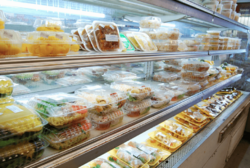
Over time the food cooked by Cambodians in the United States developed into a distinct Cambodian American variety. Meat, especially beef and chicken, plays a much more central role in Cambodian American meals, which also make much more extensive use of tomatoes and corn. The unhealthy eating habits, such as consumption of fatty meat, and obesity rates are higher for the Cambodian Americans who experienced a more severe food deprivation and insecurity in the past. The food of second and third generation Cambodian Americans has become more Americanized. Cambodian cuisine is not well known within the United States and is usually compared to Thai food by many Americans. Most Cambodian restaurants are located in cities with a significant Cambodian population, such as Lowell, Massachusetts, Long Beach, California and Seattle, Washington. Some of the Cambodian-owned restaurants, however, served other Asian cuisines, especially Thai and Chinese, whereas in the ones that served Cambodian cuisine Chinese, Thai and Vietnamese-influenced dishes usually dominated over Khmer dishes.
Long Beach, California has the most Cambodian restaurants in the U.S. – twenty two, including Phnom Penh Noodle Shack and Sophy's. Some Cambodian-owned restaurants in the city, such as Little La Lune Cuisine and Crystal Thai Cambodian, serve Thai food, while others, such as Hak Heang or Golden Chinese Express, serve Chinese food. Lowell, Massachusetts, has at least twenty Cambodian restaurants, among them Tepthida Khmer and Simply Khmer. Other notable Cambodian restaurants include Sok Sab Bai in Portland, as well as Phnom Penh Noodle House and Queen's Deli in Seattle. The most famous Cambodian restaurant in the U.S. is The Elephant Walk serving French-inspired Khmer cuisine. It was opened in 1991 in Cambridge, Massachusetts by Longteine de Monteiro. The restaurant also created a cookbook of the same name, which is the first Cambodian American cookbook.
In 2000 a part of Central Long Beach was officially designated as Cambodia Town, where since 2005 an annual parade and culture festival takes place there that also features Cambodian cuisine. Since the late 2010s there has been an emerging wave of second-generation Cambodian American chefs and restaurants in the U.S. focusing on Cambodian cuisine. Among them is the award-winning restaurant Nyum Bai opened in Fruitvale, Oakland, California in 2018 by chef Nite Yun.
Among other Southeast Asian cuisines
Due to extended culinary contacts and shared extraregional influences from India, China and France, modern Cambodian cuisine has many similarities with the neighbouring Thai, Vietnamese and Lao cuisines. Nowadays, the flavour principles of many Khmer dishes, such as sour fish soups, stews and coconut-based curries, including fish amok, are very similar to Central Thai cuisine, although Khmer dishes contain much less chilli and sugar and make greater use of aromatic herbs and spices. Both Thai and Khmer royal cuisines use special herbal spice pastes for curries, soups, and stews.
Khmer cuisine has relatively less in common with Northeast Thai and Lao cuisines, however, they all utilize a fish paste in their cooking (called prahok in Khmer, pla ra in Thai and padaek in Lao), which is believed to be a Khmer influence as both Laos and Northeast Thailand historically was part of the Khmer Empire. With Vietnamese and Lao cuisine it shares the French influence as Vietnam, Laos and Cambodia were all part of the French Indochina. Khmer dishes are less salty than Vietnamese food in general, and less sweet, sourer and more citrusy than South Vietnamese food. The ingredients and dishes of Mekong Delta's indigenous Khmer Krom, most notably spices (cardamom, cinnamon, star anise, clove, ginger, turmeric and ground coriander), curries and fermented food (such as mắm and mắm pò hóc). have influenced the cuisine of modern-day Southern Vietnam.
Ingredients
Fermented sauces
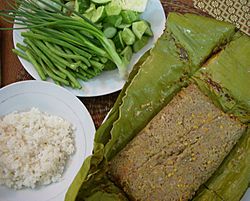
In Khmer, a distinction is made between fermented seafood depending on its consistency and the ingredient. Mam (មាំ) is the general term for seafood fermented with a special technique and usually includes more solid pieces of the fermented ingredient, whereas prahok (ប្រហុក, prâhŏk) and kapi (កាពិ, kapĭ) have more homogenous consistency than mam.
Mam is prepared by adding a mixture of salt, roasted red sticky rice and palm sugar to snakehead fillets and fermenting them for more than a year. The palm sugar and rice give mam an earthier and sweeter flavour and a reddish tone. Prahok, on the other hand, can either be made from small fish with all the bones and less salt (called prahok chhoeung) or large deboned fish and more salt (called prahok sach (ប្រហុកសាច់, prâhŏk săch)), which in turn can be made from larger fish (such as the striped snakehead (ត្រីរ៉ស់)) or smaller fish (such as trei kamplienh), with or without roe. Roe can be removed from the fish, cleaned, drained, and fermented separately. Lastly, kapi is made by pounding cleaned, dried and salted shrimp into a homogenous paste, sun-drying it for one day, pounding the paste again, sun-drying it for two more days and pounding the paste for the final time to attain a viscous consistency.
Prahok is used as flavouring for almost every Khmer dish, mixed with rice or served as a dipping sauce (ទឹកជ្រលក់, tœ̆k chrôluŏk). It can also be prepared into dishes of its own, such as prahok k'tis (ប្រហុកខ្ទិះ, prâhŏk khtih), prahok kap (ប្រហុកកប់, prâhŏk káp), teuk khreung, teuk prahok prahok ang (ប្រហុកអាំង, prâhŏk ăng), and prahok chien (ប្រហុកចៀន, prâhŏk chiĕn). Fermented roe (ពងត្រី, pông trei) are primarily eaten with steamed eggs, omelettes and other hen or duck egg dishes. Kapi is often mixed with sugar, garlic, lime juice, chilli and crushed peanuts and used as a dipping sauce for vegetables, fruit, meat and fish.
Other sauces used in the Cambodian cuisine include fish sauce (ទឹកត្រី, tœ̆k trei), oyster sauce (ទឹកប្រេងខ្យង, tœ̆k préng khyâng), soy sauce (ទឹកស៊ីអ៊ីវ, tœ̆k si-iv; តៅអ៊ីវ, tau iv; សាអ៊ីវ, sa-iv or ស៊ីអ៊ីវ, si-iv), tamarind sauce (ទឹកអម្ពិល, tœ̆k âmpĭl) and hoisin sauce (ទឹកសៀង. Fish sauce is an important ingredient in Khmer cooking, used to add saltiness to soups and noodle dishes, marinating meats or as a dipping sauce for fish. Oyster sauce was introduced by Chinese immigrants and has become a common ingredient in Cambodian cooking used to add a tangy-sweet flavour to meats and stir-fried vegetables. Oyster sauce, along with fish sauce, and soy sauce, is commonly used together when seasoning foods. Soy sauce is also a common ingredient and condiment, mixed with garlic or aged radish to be eaten with primarily high protein dishes, as well as used to add saltiness when fish sauce is not used. Tamarind sauce is made from tamarind paste mixed with fish sauce, garlic, chilli peppers, lime juice, palm sugar, and vinegar. Hoisin sauce is used to marinate grilled meat and especially for kuyteav or soups with hand pulled noodles.
Herbs and spices

The most common herbs and spices in Cambodian cuisine are sweet basil (ជីរនាងវង, chi néangvông), coriander (ជីរវ៉ាន់ស៊ុយ, chivănsŭy), hot mint (ជីរពងទាកូន, chi pông téa kon), turmeric (រមៀត, rômiĕt), garlic, ginger (ខ្ញី, khnhei), galangal (រំដេង, romdeng), kaffir lime leaves (ស្លឹកក្រូចសើច, slœ̆k kroch saeuch), neem leaves (ស្លឹកស្ដៅ, slœ̆k sdau), peppermint (ជីរអង្កាម, chi ángkam), lemongrass (ស្លឹកគ្រៃ, slœ̆k krey), chives (គូឆាយ, kuchhay), scallions, saw leaf herb (ជីរបន្លា, chi bánla), fingerroot (ខ្ខ្ជាយ, khchéay) and rice paddy herb.
Certain regions in Cambodia are known for their spices. Kampot pepper and Kampong Speu palm sugar (ស្ករត្នោតកំពង់ស្ពឺ, Skor Thnaot Kompong Speu) have been granted Geographical Indications in Cambodia and protected geographical indication in the European Union. Cardamom Mountains in Southwest Cambodia are famous for their large population of wild cardamon plants and Battambang Province for its turmeric.
The cultivation to peppercorns in Cambodia dates back to at least the 13th century and because of its "uniquely strong yet delicate aroma" and "slightly sweet, eucalyptus taste" Kampot pepper is often regarded as the world's best pepper.
Kroeung
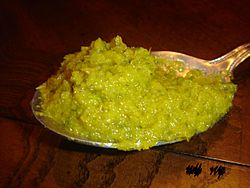
Kroeung (គ្រឿង, krœăng [krɨəŋ] – 'ingredients') is a Khmer fresh flavouring paste commonly used in curries, soups and stir-fries, one of the essential ingredients of Cambodian cuisine. The base of the paste consists of pounded lemongrass, galangal, garlic, shallots, kaffir lime leaves and turmeric. There are five common types of kroeung: yellow kroeung (kroeung samlar m’chu), green kroeung (kroeung prâhoeur) and red kroeung (kroeung samlar kari), as well as k’tis kroeung (kroeung samlar k’tis), and saraman kroeung (kroeung samlar saraman) each with different uses.
Vegetables
The Cambodian diet consists heavily of leaf vegetables, such as water morning glory (ត្រកួន, trâkuŏn), cabbage (ស្ពៃក្តោប, spey kdaôp), Chinese kale (ខាត់ណាចិន, khăt-na chĕn), betel (ស្លឹកម្លូ, mlu), vine spinach (វល្លិ៍ជន្លង់, voă chónlóng), and watercress (ច្រាច់, crac), which are used in soups, stir-fries (ឆា, chá) and salads.
Cambodian cuisine also uses different squashes, such as bitter melon (ម្រះ, mreăh), winter melon (ផ្លែត្រឡាច, phlê trâlach), kabocha, and luffa (ននោង, nong), root vegetables, such as carrots (ការ៉ុត, karŏt), cassava (ក្ដួច, kduŏch), lotus rhizomes (ឫសឈូក, rœ̆h chhuk), potatoes (ដំឡូង, dámlong), radish (រ៉ាឌី, radi), sweet potatoes (ដំឡូងជ្វា, dámlong chvéa) and jicama (ដំឡូងរលួស, dâmlong rôluŏh or ប៉ិកួៈ, pĕkuŏk) and other vegetables, such as cucumbers (ត្រសក់, trâsák), eggplants (ត្រប់, tráp), tomatoes (ប៉េងប៉ោះ, péngpaôh), cauliflower (ផ្កាខាត់ណា, phka khăt-na), chayote (ផ្លែស៊ូ, phlê su), shallots (ខ្ទឹមក្រហម, khtœ̆m krâhâm), yardlong beans (សណ្ដែកកួរ, sándêk kuŏ) and maize (ពោត, pot). Many unripe fruits, such as papaya, green banana, and mango, are also used as vegetables.
Fruits
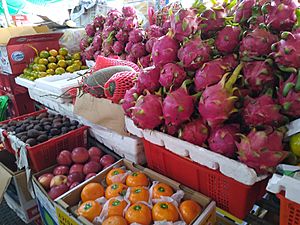
Fruits in Cambodia are so popular that they have their own royal court. The durian (ទុរេន, tŭrén) is considered the "king", the mangosteen the "queen", sapodilla (សាប៉ូឌីឡា) the "prince" and the milk fruit (ផ្លែទឹកដោះគោ, phlê tœ̆k daôh ko) the "princess". Other popular fruit include kuy fruit (ផ្លែគុយ, phlê kŭy), romduol, pineapple (ម្នាស់, mnoăh), rose apple, jackfruit (ផ្លែខ្នុរ; phlê khnŏl), papaya (ល្ហុង, lhŏng), watermelon (ឪឡឹក, âulœ̆k), banana (ចេក, chék), mango (ស្វាយ, svay), rambutan (សាវម៉ាវ, sav mav), guava (ត្របែក, trɑbaek), longan (មៀន, miĕn) and tamarind (អម្ពិល, âmpĭl).
Although fruits are usually considered desserts, some such as ripe mangoes, watermelon, and pineapples are eaten commonly with heavily salted fish with plain rice. Fruits are also made into smoothies (ទឹកក្រឡុក, tœ̆k krâlŏk). Popular fruits for smoothies are durian, mangoes and bananas. Sun-dried limes boiled in sugar and salt water are used in chicken and duck soups, sauces with fish, as well as beverages.
- Apple (ប៉ោម, paôm)
- Breadfruit (សម្, sam)
- Sugar cane (អំពៅ, ámpŏu)
- Cashew (ស្វាយចន្ទី, svaychănti)
- Coconut (ដូង, dong)
- Custard apple (ទៀប, tiĕp)
- Dragon fruit (ស្រការ, srâka)
- Key lime (ក្រូចឆ្មារ, krouc chmaa)
- Kumquat (ផ្លែកុមខ្វាត់; phlê kŏmkhvăt)
- Langsat (ឡុងកុង, lŏng kŏng)
- Lotus seeds (គ្រាប់ពូជឈូក, kroăp puch chhuk)
- Lychee (គូលែន, kulén)
- Mango plum (ម៉ាក់ប្រាង, măprang)
- Mangosteen (មង្ឃុត, móngkhŭt)
- Palmyra fruit seeds (គ្រាប់ត្នោត, kroăp tnaôt)
- Persimmon (ផ្លែទន្លាប់, phlê tónloăp)
- Pomelo (ផ្លែក្រូចថ្លុង, phlê kroch thlŏng)
- Snake fruit (ផ្លែសាឡាក់, phlê salăk or ផ្លែរកាំ, phlê rôkăm)
- Soursop (ផ្លែទៀបបារាំង, phlê tiĕp barăng – 'foreign custard apple fruit')
- Star fruit (ផ្លែស្ពឺ, phlê spœ)
- Star gooseberry (កន្ទួត, kántuŏt)
Since 2018, Koh Trong pomelos (ក្រូចថ្លុងកោះទ្រង, kroch thlŏng Kaôh Trông) are recognized as one of the geographical indications in Cambodia. Pomelos grown in the Kratié Province's Koh Trong commune are known for their sweeter taste and the absence of seeds after ripening.
Fish and meat

There are more than 900 different freshwater and saltwater fish species found in Cambodia. Approximately 475,000 tons of fish (ត្រី, trei) are caught in Cambodia every year and a Cambodian annually consumes 63 kg of fish on average. They are fried, dried, smoked and fermented into prahok and fish sauce. Fish and fish products are eaten two to three times a day. Popular fish are snakeheads, snappers, catfishes (ត្រី, trei chleang), and mackerels. Cambodian chef Luu Meng has estimated that approximately 40–50% of Cambodian dishes are made with fish.
It is known that in the late-13th century Khmer Empire cows were not used for riding, meat or hide, and the geese had been recently introduced by the Chinese sailors. Since the 1980s, the role of meat in the Cambodian diet has increased significantly and nowadays the consumption of meat, such as beef (សាច់គោ, săch koo), pork (សាច់ជ្រូក, săch chruk) and poultry, has become common, especially in the capital region. In Siem Reap ground pork or beef is made into spicy or sweet and savoury sausages (សាច់ក្រក, săch krɑɑk (pork); ខ្វាគោ, săch krɑɑk (beef)) that are eaten with steamed white rice, congee or baguettes. Beef and chicken (សាច់មាន់, săch mŏən) is stewed, grilled or stir-fried, while duck meat (សាច់ទា, săch tiə) roasted in char siu style, is popular during festivals.
Other seafood includes an array of shellfish such as crabs (ក្ដាម, kdaam), clams, cockles (ងាវ, ngiəw), crayfish (បង្កង, bang kang), shrimp and squid (ត្រីមឹក, trei mik). Boiled or fried cockles seasoned with salt, chili, and garlic are sold as a popular street food. Giant freshwater prawns are usually only eaten by middle and upper-class Cambodians because of their price. More unusual varieties of meat include frogs (កង្កែប, kɑngkaep; most commonly eaten are East Asian bullfrogs, rice field frogs, balloon frogs, banded bullfrogs, yellow frogs and Asian common toads), turtles (អណ្ដើក, ɑndaək) and arthropods (such as tarantulas (សត្វអាពីង, sata ping), fire ants, grasshoppers (កណ្ដូប, kandoup), giant water bugs and crickets (ចង្រិត, cɑngrət)). Crickets, water bugs, and tarantulas are seasoned with salt, sugar and oil, deep-fried and sold as street food.
Noodles
Cambodian noodles are made out of rice, wheat and tapioca flour (banh kanh (បាញ់កាញ់, bañ kañ)) in varying thickness. Wheat noodles, such as hand-pulled noodles (មី, mii) and the thinner wheat vermicelli (មីសួ, mii suə), have been adopted from the Chinese cuisine, but incorporated into distinct Cambodian noodle soups and stir-fries. Rice noodles include the indigenous lightly-fermented num banhchok (នំបញ្ចុក), as well as rice vermicelli (គុយទាវ, kŭytéav), banh sung (បាញ់ស៊ុង, bɑɲ song), silver needle noodles (លត, lat) and banh hoi (បាញ់ហយ).
Dishes

In Cambodia, street food (ម្ហូបតាមផ្លូវ) is considered a snack rather than a meal. Food stalls are called hang bai (ហាងបាយ) or simply hang (ហាង) in Khmer, which is a borrowing from Chinese háng ("store", "business"). More specifically the stalls are referred to by the main food served, for example, rice noodle stalls (ហាងគុយទាវ, hang kŭytéav) or coffee stalls (ហាងកាហ្វេ, hang kafe).
Noodle soups
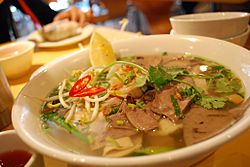
Soups, stews and curries
Samlar (សម្ល) refers to soup dishes that are eaten with rice, while the loanword sup (ស៊ុប) refers to dishes that can be eaten without rice, these usually being dishes of Chinese or French origin.
Stir-fries and rice dishes
The Khmer term cha (ឆា) refers to the stir-frying technique adopted from the Chinese.

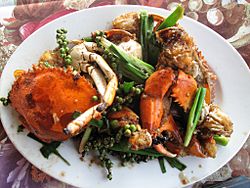
Salads, rolls, and steamed foods
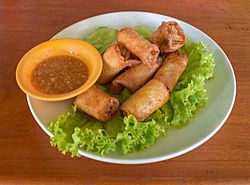

There are two types of salads – gnoam with cooked meat and p'lear where the meat is either raw or cured in a citrus dressing.
Pastries
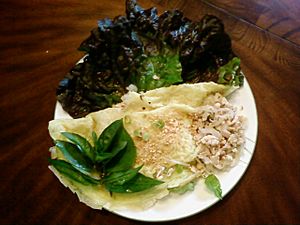
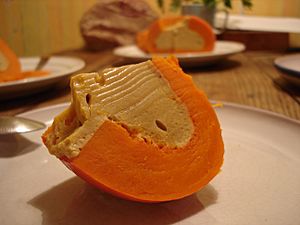
Most Cambodian pastries use either rice or tapioca flour, whereas in Chinese and French-influenced pastries (such as num pao) wheat flour may also be used.
- Saku (tapioca dessert)
- A type of steamed dessert made from chestnut flour, coconut milk, and cooked mung beans.
- Sesame balls (នំក្រូច, num kroch – 'orange cake')
- A fried pastry with a mung bean filling brought to Cambodia by Chinese immigrants. The Khmer name "orange cake" refers to the fruit it resembles.
Sticky rice dishes and dumplings
- Bai ben (បាយបិណ្ឌ)
- A sticky rice dessert that is moulded into a ball and topped with sesame seeds. It is very popular during Pchum Ben.
- Durian sticky rice (បាយដំណើបទុរេន, bai damnaeb tŭrén)
- A sticky rice dessert topped with sweet coconut milk and slices of durian fruit. A variation of that is mango sticky rice (បាយដំនើបស្វាយ, bai damnaeb svay).
- Siev mai (ស៊ីវម៉ៃ)
- A Cambodian rendition of a Chinese pork dumplings. In Khmer, "siev mai" refers not only to the dumpling but also a style of meatballs created by the southern Chinese immigrants in Phnom Penh.
- Steamed sticky rice cakes
- Glutinous rice flour pastries steamed in banana leaves with different sweet or savoury fillings. The pyramid-shaped num chang are filled with pork, sausage, and beans and are derived from Chinese zongzi, the pyramid-shaped num bot (នំបត) are filled with mung bean paste and the pyramid-shaped num kom (នំគម) are filled with a mixture of coconut shavings, toasted sesame seeds and palm sugar. The cylinder-shaped num ansom (នំអន្សម) can either be filled with sugar bananas (នំអន្សមចេក, num ansom chek) or jackfruits (នំអន្សមខ្នុរ, num ansom khnao), or pork (នំអន្សមជ្រូក, num ansom chrouk). In addition to steaming num ansom can also be fried or grilled depending on the occasion. The cylinder shape symbolizes Shiva, the masculine principle of God, while the pyramid shape symbolizes the Shakti, the feminine principle of God. Sticky rice cakes are given as offerings to the manes of the ancestors on Pchum Ben to gain their blessing to the rice fields.
- Tapioca pearl balls (នំសាគូ, num saku)
- Tapioca balls with a meat filling. Minced meat is seasoned and cooked then wrapped in a tapioca mixture and steamed. The dish is often served with vegetables and sweet sauce. It is similar to Thai sakhu sai mu, Lao khao nom sakoo and Vietnamese bánh ít trần.
Puddings, sweet porridges and jellies
Cambodian desserts include puddings (ចាហួយទឹក, cha houy teuk), sweet porridges (បបរផ្អែម, babor p'aem) and agar jellies (សារាយ, sarai).
- Grass jelly (ចាហ៊ួយខ្មៅ, cha huoy khmaw)
- Often eaten with soybean milk during a hot day because of its cooling properties.
- Num lot
- A green or white dessert made from rice flour in a liquid of coconut, milk, water and sugar. A similar dish is Indonesian cendol.
Beverages
Water is the most popular drink. As drinking water sources are not always easily accessible in rural areas water is boiled at home and consumed hot. In urban areas bottled water, as well as soda and sweetened fruit beverages, is available. Green tea (តែបៃតង, tê baitâng) is consumed throughout the day. It is believed to have been introduced in the Khmer Empire by the Chinese, but despite the growing consumption and suitable climate nowadays most green tea is imported and very little is actually grown locally. Camellia sinensis cambodiensis, a local strain of the tea plant, grows in the Kirirom National Park, in the remnants of a former 300-hectare tea plantation established in the 1960s by the King Norodom Sihanouk, and the area around Chamkar Te village in Mondulkiri Province. Recently, there have been efforts to revive the Cambodian tea production. Lemon iced tea (តែទឹកក្រូចឆ្មា, tae krouc chmaa) is also prepared and consumed.
In urban areas coffee (កាហ្វេ, kaafee) is also popular and is usually served with sweetened condensed milk rather than black. Coffee can be consumed either iced (កាហ្វេទឹកកក, kaafee tœ̆k kɑɑk) or hot. It is sold in coffee carts, coffeehouse chains and specialty coffee shops. More than 90% of all coffee in Cambodia is imported from other countries, such as Vietnam, Laos, and Thailand.
Smoothies (ទឹកក្រឡុក, tœ̆k krɑlok) are an important part of an evening's consumption available at juice stalls in towns all over the country from the late afternoon. They can contain a mixture of fruits or just one or two; coconut milk, sugar syrup, condensed milk and shaved ice are also added, as is a raw egg (unless specified otherwise – ot yoh pong mowan). Soy milk (ទឹកសណ្ដែក, tœ̆k sɑndaek) is sold in the morning by street vendors; the green version is sweetened and thicker than the unsweetened white. Served either hot or cold, sweetened or unsweetened. Sugarcane juice (ទឹកអំពៅ, tœ̆k ʼɑmpɨw) is also a popular street drink made by pressing the juice out of sugarcane stalks with a special machine. Served with ice and sometimes flavoured with citrus to balance the sweetness. Pandan juice (ទឹកតើយ, tœ̆k taeuy) is made from the extract of pandan leaves and usually sold in Cambodian food stalls.
Fermented beverages
According to the Chinese diplomat Zhou Daguan, five fermented alcoholic beverages were produced in the late-13th century Khmer Empire: mead, pengyasi made from the leaves of an unidentified plant, baolengjiao made from rice hulls and rice leftovers, "sugar-shine wine" made from sugar and palm starch wine made from the starch of the leaves of a palm growing on the riverbank.
Nowadays, the most popular alcoholic beverage is beer (ប៊ីយេរ, biiyɛɛ). The first domestically brewed beer was produced in the 1930s during the French Indochina period by the Brasseries & Glacières de L'Indochine company in Phnom Penh. In 1995 the annual beer consumption per capita was only around two liters, but by 2004 it began to rise significantly and in 2010 beer overtook spirits as the most popular alcoholic beverage in Cambodia. Currently, the four biggest beer producers in Cambodia are the Cambrew Brewery, Cambodia Brewery, Khmer Brewery and Kingdom Breweries. Recently there has also been a quickly growing craft beer scene with 12 brewpubs or microbreweries operating in Cambodia in 2019.
A popular traditional alcoholic beverage is rice wine (ស្រាស, sra sa). It is produced by fermenting boiled and dried rice with a natural fermentation starter (dom bai) for at least 24 hours and distilling the resulting mixture. Modern distillation methods were introduced during the French Indochina period. Occasionally, there have been instances of methanol poisoning from low quality home-made rice wine. Rice wine can also be infused with various herbs, roots, bark and insects to create medicinal rice wines (srah tinum). A popular drink infused with deer antlers and different herbs is the Special Muscle Wine manufactured since 1968 by Lao Hang Heng Wine. The company also produces popular Golden Muscle Liquor and Wrestler Red Wine, whereas Sombai manufactures a line of premium infused rice wines.
Another popular, albeit lower-prestige alcoholic beverage is palm wine (ទឹកត្នោតជូរ, tœ̆k tnaot cuu). It might have become popular during the French Indochina period as a cheap alternative to other wines. Palm wine is produced by fermenting Asian palmyra palm sap either through spontaneous fermentation by adding several plants to the sap and hanging the containers on trees or through the addition of a fermentation starter (ម៉ែទឹកត្នោតជូរ, mae tœ̆k tnaot cuu) made from fermented palm sap and various dried plant xylems and bark. Confirel in Pou Senchey District uses the Champagne method to produce sparkling palm wine under the name "Thnot Sparkling Mekong Wine".
A regional beverage of the Mondulkiri Province is yellow and purple passion fruit wine. Samai Distillery, Cambodia's first rum distillery, produces rum and even uses Kampot peppercorns in one of its products and Cambodia's first and only winery Chan Thai Choeung In Battambang has been commercially producing grape wine since 2005.
Meals and eating etiquette
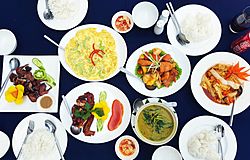
In Cambodia, meals are usually freshly prepared three times a day (for breakfast, lunch and dinner), although in rural areas only breakfast and dinner may be eaten. Due to a general lack of refrigeration, leftovers are usually discarded. A typical Cambodian breakfast consists of rice porridge with dried salted fish, rice with dried salted fish and vegetables, baguette with condensed milk or rice/egg noodles with meat and leaf vegetables. For lunch and dinner, Cambodians usually eat steamed rice, soup with meat (fish, pork, chicken or beef) and leaf vegetables, fried fish or other meat and fruit.
In Cambodian meals just like the rest of Southeast Asia, all dishes are served and eaten simultaneously, as opposed to the European course-based meal format or the Chinese meal with overlapping courses. The only exception is if the meal contains French-style dishes, in which case the dishes are served in courses. A number of side dishes are usually served alongside the main dishes. In addition to that, a variety of condiments, such as chili jam, pickled green chillies, sugar, garlic flakes, fish sauce and soy sauce, are also available. While steamed rice and soups are usually served hot, side dishes may be served at room temperature. The balance of flavours and satisfaction of individual preferences are achieved by combining the individual dishes and rice. For example, a Cambodian meal may consist of a sour soup, a salty fish, fried vegetables and plain rice, which is different from Thai food where sourness, saltiness, sweetness and spiciness are usually contained within a single dish.
Khmer food is traditionally eaten with hands, but nowadays spoons, forks and chopsticks are also used. Knives are rarely used as the majority of Cambodian food is already cut into bite-sized pieces. Forks and spoons were introduced by the French and are used for eating rice and/or soup-based dishes, whereas chopsticks were introduced by the Chinese and are used only for eating noodle dishes.
International popularity
Cambodian cuisine is not very known across the world. The website Far & Wide has listed Cambodian cuisine as one of the 25 most underrated cuisines in the world and Food Republic has described Cambodian as "The Greatly Underappreciated Outlier In Asian Cooking". Fodor's Travel has called Cambodian cuisine "the most underrated in Southeast Asia" and Siem Reap "SE Asia’s Most Underrated Food Destination", while the magazine Time Out has named Kep one of "18 of the world’s most underrated food cities"
Over the past three decades, the West has fallen in love with the cuisines of Thailand, southern China, Vietnam and Malaysia, even Burma (for its barbecue), but somehow, Cambodia's food has slipped through the cracks.
—Matthew Fishbane, "Will Cambodian food ever catch on in America?" (2007)
Outside of Cambodia, Cambodian cuisine can generally be found in countries with sizeable Cambodian immigrant communities, such as the United States, France, Australia and Canada, especially in the Little Cambodia ethnic enclaves, but it is often aimed towards the local Cambodian community. Due to commercial considerations and the ethnic composition of the Cambodian diaspora many Cambodian-owned restaurants have chosen to serve the better-known Thai, Chinese and Vietnamese food instead.
Culinary diplomacy
In December 2020, the Ministry of Foreign Affairs and International Cooperation launched an official "Food Diplomacy 2021–2023" campaign as part of a larger economic diplomacy strategy. At the launch Minister of Foreign Affairs and International Cooperation Prak Sokhonn listed prahok, fish amok, pomelo salad, samlar kako, coconut-pineapple curry (samlar k'tis), coconut prahok dip and num banhchok as some of the Khmer dishes to be promoted in the campaign. The ministry also established a program to train Cambodian cooks for serving in Cambodian embassies and a program for providing ambassador spouses with knowledge about the Khmer cuisine.
In February 2021, the ministry published a cookbook "The Taste of Angkor" as a culinary promotion tool for Cambodian diplomatic missions abroad. A 1960 Cambodian cookbook and culinary guide "The Culinary Art of Cambodia" by Princess Norodom Rasmi Sobbhana republished in May 2021 by Angkor Database was also included in the campaign. In June 2021, a series of promotional videos under the slogan "Taste Cambodia" featuring Khmer foods and culinary activities in different Cambodian regions commissioned by the Ministry of Tourism of Cambodia were released. In May 2022, culinary training and representation facilities under the name of "Angkor Kitchen" were unveiled at the Ministry of Foreign Affairs and International Cooperation.
Awards
Cookbooks
The cookbook "From Spiders to Water Lilies, Creative Cambodian Cooking with Friends" published by non-governmental organization Friends-International has received the 2009 Gourmand World Cookbook Award as the "Best Asian Cuisine Cookbook", becoming the first book from Cambodia to win the award.
The French-language Khmer cookbook Au Pays de la Pomme Cythère, de Mère en Fille, Authentiques Recettes Khmères written and self-published by Kanika Linden and her mother Sorey Long has won the 2010 Gourmand Awards as the world's "Best Asian Cuisine Cookbook". The English-language version of the book "Ambarella, Cambodian Cuisine" has won the 2013 Gourmand Awards as the "Best Asian Cuisine Cookbook" in the UK and world's "Best Asian Cuisine Cookbook" in 2014.
The cookbook "The Taste of Angkor" published by the Ministry of Foreign Affairs and International Cooperation of Cambodia has won the 2021 Gourmand World Cookbook Award as the "Best Asian Cookbook" and 2022 Gourmand World Cookbook Awards as the "Best Asian Cuisine Book" and "Heads of State/Food" for the book's foreword written by Deputy Prime Minister Prak Sokhon.
The republished Cambodian cookbook and culinary guide "The Culinary Art of Cambodia" has received the "Special Award of the Jury" at the 2022 Gourmand World Cookbook Awards.
Restaurants
Joannès Rivière's Cuisine Wat Damnak has been included in position No. 50 of Asia's 50 Best Restaurants in 2015, becoming the first Cambodian restaurant to make the list. In the 2016 list it rose to the 43rd position. In 2020, the restaurant Embassy spearheaded by the Kimsan Twins was included in the Asia's 50 Best Restaurants newly created 50 Best Discovery list.
Chefs
Cambodian chef Luu Meng has received Asia's Top Chef award from the Malaysia-based business and lifestyle magazines "Top 10 of Malaysia" and "Top 10 of Asia" in 2014.
Cambodian chefs from the Cambodia Chefs' Association have won the 2019 ASEAN Gourmet Challenge with three gold medals, as well as received six silver and 17 bronze medals in the Global Pastry Chefs Challenge and Global Young Chefs Challenge categories at the Thailand Ultimate Chef Challenge taking place from 28 May to 1 June in Bangkok.
See also
 In Spanish: Gastronomía de Camboya para niños
In Spanish: Gastronomía de Camboya para niños


